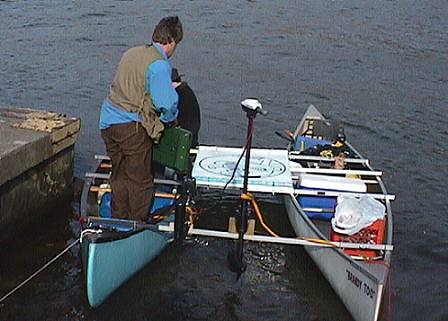
The Popeye Expeditions
On the morning of November 24th, 2001 a crew of 4 departed near the Birmingham Bridge in the South Side area of Pittsburgh, Pennsylvania for a 27 mile trip down the Monongahela and Ohio Rivers to Rochester, Pennsylvania in an improvised canoe/catamaran. This first expedition took us through the Emsworth locks and the Dashields locks. The trip was leisurely and allowed us to cook a very satisfying meal on the evening leg of the expedition. Roughly 12 hours later, the expedition was successfully completed in unseasonably warm weather. Navigation charts, provided by the U. S. Army Corps of Engineers, were utilized for identification of sites along the rivers. The deck between the canoes features a picture of Popeye and future trips are being planned, thus the name of these expeditions. The crew has lofty plans on annual expeditions to eventually make their way to New Orleans via the Mississippi River.
An improvised canoe/catamaran was built keeping this criteria in mind...
Easy on the pocketbook (we had the canoes, lots of spare materials but not a lot of money)
Easy to transport (lightweight and compact enough to move in/on a car)
Easy to assemble (fast, on-site construction with no alteration to the canoe hulls)
This craft was propelled by a quiet Minn Kota electric trolling motor which made the trip more enjoyable. Electrical power was provided using a quantity of two of 205 amp/hour deep cycle batteries from Batteries Plus. Lashing bars from Spring Creek were used to attach the canoe hulls together which provided a stabile platform. The lashing bars are made of telescopic, square metal tubing. Additional metal tubing was added for extra strength, a motor mount and deck support. The source of this tubing was primarily recycled Steelcase office furniture. The tubing snaps together without tools by use of spring snap buttons from Valco. The project is similar to a milder combination of the television shows: Monster Garage and Junkyard Wars. Preliminary and intermediate testing of the canoe/catamaran is done at Canonsburg Lake.

Preparing for departure from the Monogahela River at the South Side section of Pittsburgh

Passing through the Emsworth locks

Relaxing

Cooking Dinner in the Galley
Lessons learned from the first expedition led to new modifications made for the 2nd expedition on 11/23/02. The second expedition started where the last one left off, in Rochester, Pennsylvania and was to proceed roughly 22 miles down the Ohio River near Wellsville, Ohio and the confluence of the Beaver River. This trip will take us through the Montgomery locks. This trip was to be shorter than desired due to expected construction delays at the New Cumberland locks. Unlike the first expedition, colder temperatures and wetter conditions were expected which raised the crews' awareness for prevention and treatment of hypothermia.
Since modifications are done on a limited budget, it adds to the challenge rather than the purchase of a real boat. since the first expedition, the deck area has been increased for general usage and to minimize water intake from splashing between the hulls. Deck panels were keyed with pins for increased durability and easier assembly. Emergency floatation was added using recycled packing materials made of Ethafoam and glued beneath the decking using Liquid Nails adhesive. A rain top has been designed with consideration for effects of wind loading. Less weight in general will increase the amount of "freeboard" (how far above the water the boat sits) which will help prevent the canoe/catamaran from becoming "swamped" (taking on water) mainly caused by the wakes of passing barges. Future considerations are to have these expeditions accommodate charity fund raising.
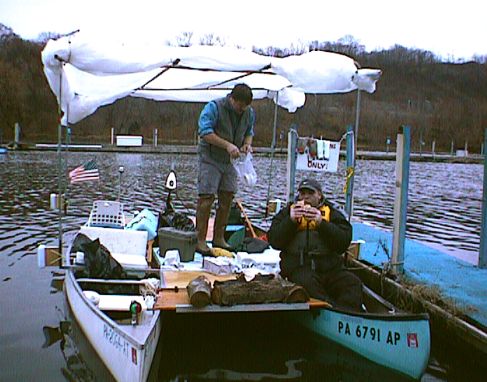 ,
,
On the Beaver River with new roof, fold-down sides & additional decking
Unfortunately the second expedition did not go as planned. 30mph wind gusts causes high waves that threatened to swap us within the first mile down the Ohio River. Rather than scrap the mission, we still made a day of it (and most of the night) by heading up the Beaver River several miles until we encountered a dam with no lock. We then found a good spot to land and proceeded to have enjoy a campfire and a feast. The voyage back to where we started was in the early morning, the now calm water had a mirror effect, lights glistened and we kept running into the same flock of Canadian geese until we got back to the Ohio River.
The second expedition taught us a few lessons. Unlike our first expedition, Novembers can be pretty cold on the river. We decided that the next time we would choose October which should be warmer while still having the benefit with much less pleasure craft to contend with.
The third expedition was on 10/25/03 and was going to attempt the same route that defeated the crew on the previous expedition however expected wind gusts caused us to pick another route on the Monongahela River closer to Pittsburgh. With only the two founding crew members, we put in at New Eagle around noon, went 15 miles down the Monongahela, through the locks at Elizabeth, to the confluence of the Youghiogheny River at McKeesport. Weather was in the 60s, partly sunny and the water was calm. Later that evening, at McKeesport we picked up our third original crew member then continued up the Youghiogheny for a few miles, then went back up the Monongahela and at around 2AM we found a spot for a campfire where most of the crew slept while one crew member slept aboard the catamaran. The next morning we took out at McKeesport and was packed up to leave shortly after 11AM.

Plenty of room on deck for sleeping onboard
We are still determined to conquer that stretch of the Ohio in the future. The canoes used for the previous expeditions were a 17', 2" Mohawk fiber glass canoe better suited for flat water and a 17', 2" Old Town Tripper. The Mohawk canoe has now been replaced with a 16', 9" Old Town Discovery. Compared to the Mohawk, the Discovery canoe has more freeboard which better resists swamping while providing for a more level deck and has the same payload as the Tripper canoe (1100 pounds for each canoe or 2200 pounds total)).
A new modification has been made which has been termed as "wave deflectors". It is a method of effectively increasing the hulls' overall height in the front by another 10". It is done by adding an extra lashing bar to the bow with 2 upright supports. The rooftop option already provides 4 upright supports for a total of 6 distributed around the outside of the catamaran. Nylon twine is then strung through holes drilled in the uprights and pulled tight. Plastic would then be taped to the gunwales and then over the twine. If rough water calls for this option we'll try it out and see how well it works. Additionally, self sticking weather stripping foam tape was placed between the gunwales and decking to act as a gasket and prevented water (that can splash between the hulls) from getting between the decking and gunwales.
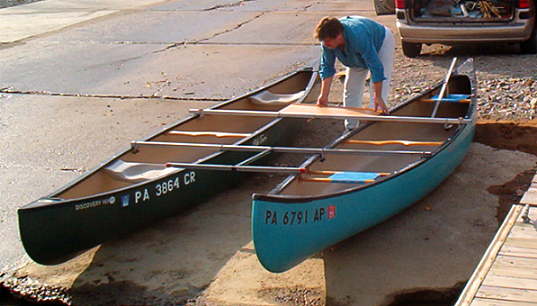
Structural lashing bars visible during assembly process
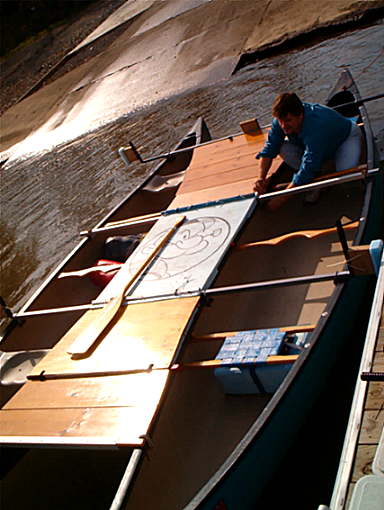
Decking installed on top of lashing bars
The fourth expedition was on 11/15/03 from Boston, PA on the Youghiogheny River at McKeesport down river roughly 20 miles past Braddock, Pa to the Southside area of Pittsburgh on the Monongahela River. This route basically took off from where our previous expedition ended. While underway, we discussed the possibility for extended motor runtime by hooking up our marine batteries in parallel for the next trip compared to our current practice of using one battery until diminished then disconnect and connect to a spare. Onboard were three members of the original crew plus a new crewmate.
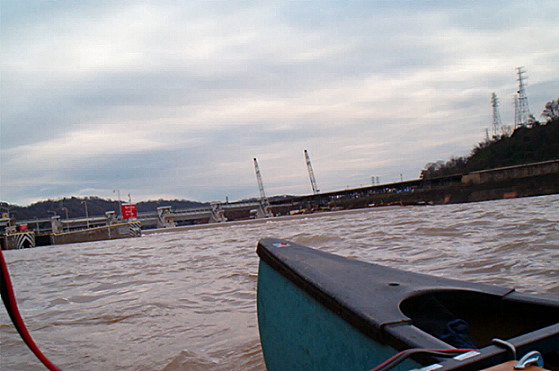
View of exiting Locks and Dam #2 at Braddock, Pennsylvania
In the picture above you can see water running over the fixed crest dam and behind that is the new gated dam which sort of looks like a bridge. The U. S. Army Corps of Engineers has extensive plans that include demolition of the old dam while putting the new dam into service. The new dam will raise the height of the river on the pool to where Locks and Dam #3 are located upriver at Elizabeth, PA. The U. S. Army Corps of Engineers are currently dredging the pool from Locks and Dam #3 upriver to Locks and Dam #4 at Charleroi, PA. This is because Locks and Dam #3 will eventually be demolished and the river height will then lower upriver from Elizabeth and likewise the depth will be raised down river from Elizabeth via the new dam.
One benefit of the dam removal is an increased migration area for aquatic species by effectively combining the two existing pools into one. Dam removals are endorsed by many environmental groups a well as the Pennsylvania Fish & Boat Commission. Another benefit is faster river navigation by eliminating an additional lock through, something that most barge operators will appreciate. For our crew, this expedition and the last were opportunities to pass by structures that will no longer exist in the coming years.
The fifth expedition took place starting at Freeport, PA on 11/12/04 where half the crew assembled the canoe catamaran in the evening then went north 1 mile up on the Allegheny River and 1 mile up on the Kiskiminetas River to sleep. The next morning we returned to Freeport to pick up the other crew members and headed 29 miles down the Allegheny River, around "the point" in Pittsburgh, then three miles up the Monongahela River where we took out near the Birmingham Bridge at South Side in the early morning hours of 11/14/04.
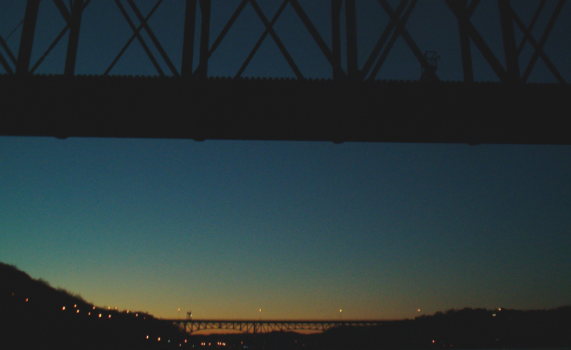
Lock and Dam #2 at the Highland Park Bridge on the Allegheny River
This expedition was 36 miles total and included three locks. Of all the expeditions, this was the longest in terms mileage, time on the river and the most amount of locks (three). This required a purchase of an additional deep cycle battery. We experimented tying our two previous batteries in parallel which worked well. We also used a new portable marine radio to notify the lock operators of our arrivals. There are very few recreational boats on the water this time of year and less commercial traffic on the Allegheny River compared to the Ohio and Monongahela Rivers which allowed for us to lock through without waiting. After the last lock, the crew took a dinner break on a nearby island we then proceeded in the dark and in temperatures in the 20s to the surreal surroundings of downtown Pittsburgh.
World Wide Web searches show that few have used a water craft such as our canoe/catamaran. If you have experience with lashing canoes together, please share them by sending our crew a note at: pb0q@andrew.cmu.edu
Related websites...
Mark McLain's Canoe Catamaran and the "Cruising America's Waterways" Homepage which hosts his info
A picture of someone else lashing canoes together
Starwest Adventures - Canoe Catamaran
Campanoe - The Ultralight Camping Houseboat